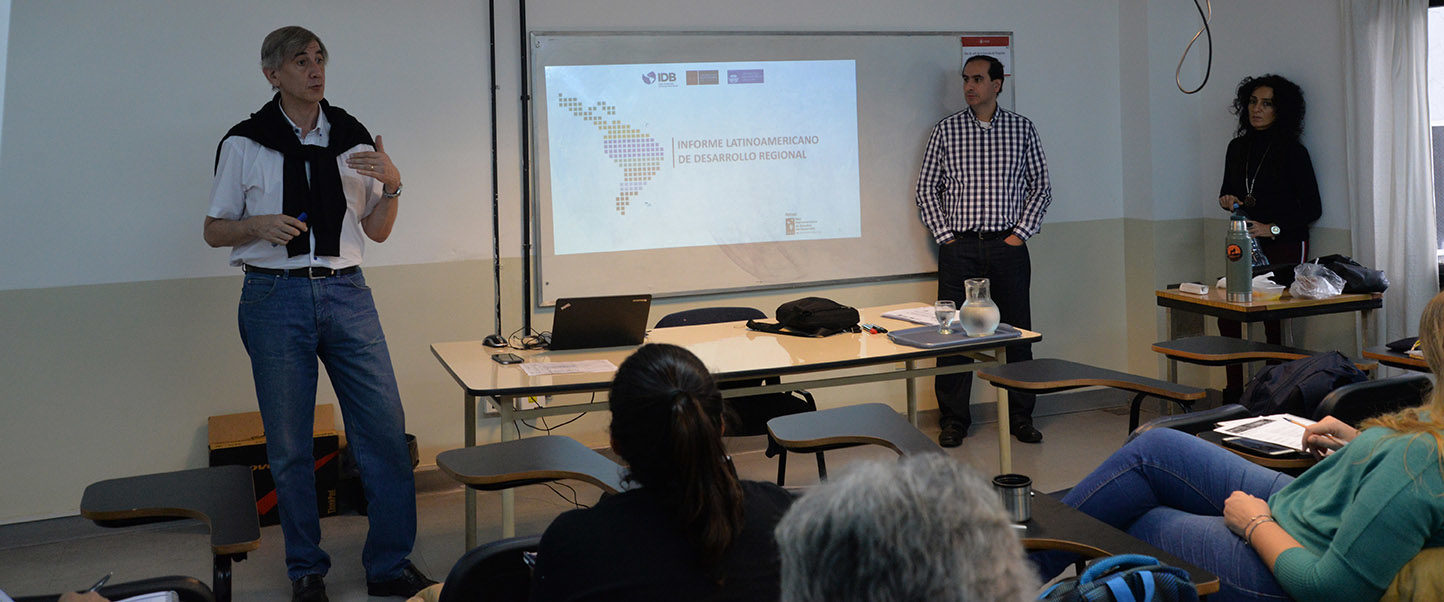The Regional Development Index was presented at the Graduate School
UTNBA is the only Argentine School that participated in the preparation of the indicator, in which eight universities from different Latin American countries participated.

The UTN Buenos Aires Master in Territorial Development presented the Regional Development Index (IDERE, in Spanish), prepared by Universities from Chile, Uruguay, Brazil, Mexico, El Salvador, Paraguay, Colombia, and Argentina, at the Graduate School premises.
The UTNBA Master’s program in Territorial Development was the only representative of the country that participated in the project, through its Director, Dr. Sergio Pérez Rozzi, and Carolina Sessa, guest professor.
The IDERE is a tool to measure development at a territorial level from a multidimensional perspective, which makes it possible to analyze trajectories and asymmetries of dimensions considered critical in human development, grouping them according to the regions of each country, verifying territorial inequalities and existing gaps.
The presentation was attended by Dr. Adrián Rodríguez Miranda, from the Economics Institute of the Economics and Administration School of Universidad de la República (UdelaR) and teacher of the UTNBA Master in Territorial Development, who invited the School to participate in the project.
“The Regional Development Index is an innovative project that originated from an initiative of two Universities, the University of Chile and the UdelaR. The indicator sought to measure beyond the development pattern of the countries and to avoid concentrating on inland regions. The project generated interest not only in those two countries,” explained Dr. Pérez Rozzi.
“By expanding it,” he continued, “Rodríguez Miranda invited us to form a research team composed by Carolina Sessa and myself to work on the design of the indicator in Argentina. What we did was join a team of eight countries that are represented by eight public universities of those countries, with the addition that the Inter-American Development Bank (in Spanish, BID) got interested and so it will fund the publication because there is no history of an indicator of regional development in Latin America.”
Dr. Adrián Rodríguez Miranda explained that “the intention is to measure development with a multidimensional approach, that is, not only the economic or productive dimension but also considering other dimensions such as health, education. Now we take the gender dimension, the dimension of social cohesion and socio-economic development, quality of institutions, among others. We arrived at this definition through various workshops and consultations with experts made in the Chile-Uruguay pilot; then we conducted a survey in Latin America, in which not only experts from Argentina participated, but also from Brazil, Mexico, and different Latin American countries. In total, there were 210 experts, mostly from the academic sector, to define which development dimensions were important.”
Once the Chile – Uruguay indicator was presented, an agreement was signed with the BID to scale up the project and incorporate more countries with the aim of forming a Latin American vision.
The economist Carolina Sessa, in charge of the preparation of the IDERE for Argentina, explained that the indicator has, in its global scale, 8 dimensions and 33 variables: “it is very solid because it was conceived with academic solvency. Professionals from different countries analyzed together what data could be assembled from all countries which were coherent and homogeneous between countries, so the result of this indicator is very solid and strong. “
“The economic activity dimension includes six indicators: household income in dollars, a GDP per capita – which is approximated because in Argentina there are no updated GGP data, so it was based on an approximation with data from the wage bill and the national GDP, making a structure with the projections of the population by province. This dimension also includes roads, internet connection and unemployment.”
The economist said that these indicators revealed that “many of the southern provinces appear in the first places both in Argentina and in IDERE in general, so what needs to be done is to clarify why this phenomenon occurs. Because this is a picture. The data for 2017 and 2016 were taken and supplemented with an analysis of the causes, the same thing happened with the other dimensions.”
Sessa also highlighted that Argentina has the best performance in Education as well as in health, “but in environment and gender we rank last with respect to other countries. The potential to analyze, to understand what is happening in Argentina and to do politics with this indicator, is enormous.”



